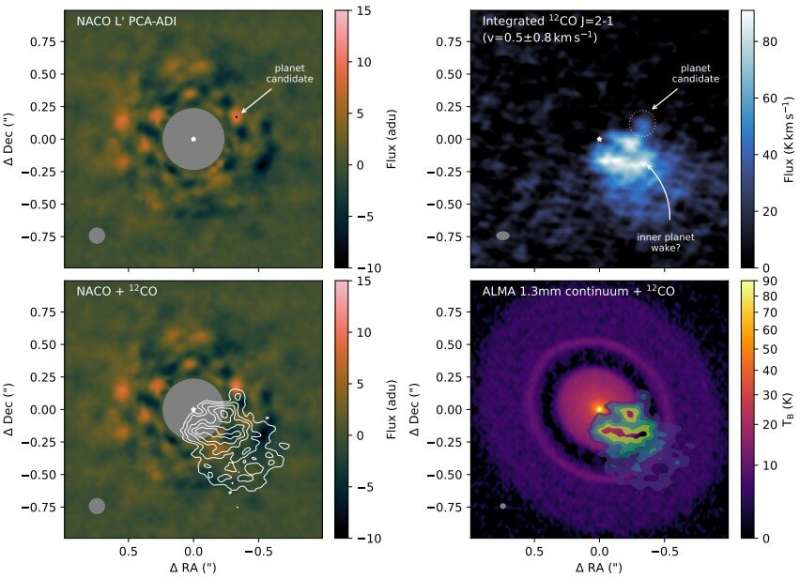This article has been reviewed according to Science X's editorial process and policies. Editors have highlighted the following attributes while ensuring the content's credibility:
fact-checked
peer-reviewed publication
trusted source
proofread
New research provides fresh insight on planet formation

The Atacama Large Millimeter Array (ALMA)—an astronomical interferometer of 66 telescopes in northern Chile, captured an exquisite image of the protoplanetary disk surrounding the young star known as Elias 2-24—but scientists noticed a mysterious hole in the image.
In 2021, Jorquera et al used the greatest telescope in the world (ESO's Very Large Telescope) to take a visible-light image of the same star.
By masking the central star, they revealed a planet candidate, but there are also other blobs present, making it impossible to confirm whether or not the detection of the planet was genuine.
New research lead by Monash University astrophysicists and published in the Monthly Notices of the Royal Astronomical Society: Letters (MNRAS) has delved into historical data and found some intriguing results.
"Our research has revealed an unusual reversal in the flow of gas at this site, as shown in the emission of glowing carbon monoxide," explains lead study author Associate Professor Christophe Pinte from the School of Physics and Astronomy.
"This suggests a local disturbance to the flow of gas in the disk, and thus the presence of a huge body, such as a planet," he said
"As a result, we now have two separate techniques to seek out young planets while they are still concealed within their home disks."
The research team combined images from the Atacama Large Millimeter Array and the ESO Very Large Telescope, two of the most powerful telescopes in the world, with computational models built at Monash University to try to understand the conditions under which such a planet may have evolved.
The mass of the planet controls the flow of gas around it. These new results provide the first constraints on the size of the planet, suggesting that it is at least twice as large as Jupiter.
Monash Ph.D. candidate Iain Hammond said even more intriguing was the apparent existence of a 'warm patch' there, where the gas was being locally heated by something.
All of this may be reproduced in models where a planet is located within a planetary disk, but only if the planet is actively consuming material and producing heat.
"The signs tend to show a planet embedded within Elias 2-24 that is causing a disturbance in the flow and warming its surroundings, indicating that it is still undergoing formation," said Iain.
"This brings us a great deal closer to figuring out how planets are formed. The question of how planets form continues to intrigue scientists.
"You can have a planet with a cool surface temperature from gradual core accretion or a considerably hotter one from rapid gas collapse owing to instabilities."
"With the discovery of significant heat production in the Elias 24 system, scientists may begin to put several planetary formation theories to the test," said co-lead study author Professor Daniel Price, also from the School of Physics and Astronomy.
"Soon, we should have access to fresh information that should provide light on which hypothesis best explains planetary formation," he said.
More information: C Pinte et al, Kinematic and thermal signatures of the directly imaged protoplanet candidate around elias 2-24, Monthly Notices of the Royal Astronomical Society: Letters (2023). DOI: 10.1093/mnrasl/slad010.
on arXiv: DOI: 10.48550/arxiv.2301.08759
Provided by Monash University




















